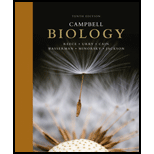
Concept explainers
To describe: Three specializations of the plant organs and plant cells that help them to adapt their life on the land.
Introduction: Vascular plants, also called tracheophytes, form a large group of plants that use specialized tissues for transporting water and food to several parts in the plant.
Explanation of Solution
There are three essential organs of the vascular plants such as the leaves, stems, and roots. Also, there are various plant cells that help in the adaptations of plants on land. For example: the parenchyma cells, sclerenchyma cells, collenchyma cells, the xylem’s water-conducting cells, and phloem’s sugar-conducting cells.
The three specializations of the plants are as follows:
1. Roots: Roots are present in the soil, where it helps in absorbing the water and minerals and stores the carbohydrates. At first, the roots forms primary roots, and then it forms the lateral roots. For acquiring the nutrients and other substances, root hairs are essential, which are beneath the soil.
2. Stems: It is an organ of the plant that comprises the buds and leaves. The most important function of the stem is in elongating and orienting the shoot, so that it would initiate photosynthesis at a maximum rate. The stem consists of internodes, nodes, axillary buds, and the apical buds.
3. Collenchyma cells: These are the cells that are elongated generally and possess thicker primary walls. The walls are thicker than the parenchymatous cells. These cells are essential for supporting the young parts of the shoots of the plants. These cells help in providing support (flexible) without restraining the growth of the plant.
The three essential organs of the vascular plants are leaves, stems, and roots; the three essential plant cells are parenchyma cells, sclerenchyma cells, and collenchyma cells, which help them in adapting their life on the land.
Want to see more full solutions like this?
Chapter 35 Solutions
Campbell Biology Plus Masteringbiology
- Molecular Biology Question A gene that codes for a protein was removed from a eukaryotic cell and inserted into a prokaryotic cell. Although the gene was successfully transcribed and translated, it produced a different protein than it produced in the eukaryotic cell. What is the most likely explanation?arrow_forwardMolecular Biology LIST three characteristics of origins of replicationarrow_forwardMolecular Biology Question Please help. Thank you For E coli DNA polymerase III, give the structure and function of the b-clamp sub-complex. Describe how the structure of this sub-complex is important for it’s function.arrow_forward
- Molecular Biology LIST three characteristics of DNA Polymerasesarrow_forwardMolecular Biology RNA polymerase core enzyme structure contains what subunits? To form holo enzyme, sigma factor is added to core. What is the name of the structure formed? Give the detailed structure of sigma factor and the function of eachdomain. Please help. Thank youarrow_forwardMolecular Biology You have a single bacterial cell whose DNA is labelled with radioactiveC14. After 5 rounds of cell division, how may cells will contain radioactive DNA? Please help. Thank youarrow_forward
- 1. Explain the structure and properties of atoms and chemical bonds (especially how they relate to DNA and proteins). Also add some pictures.arrow_forward1. In the Sentinel Cell DNA integrity is preserved through nanoscopic helicase-coordinated repair, while lipids in the membrane are fortified to resist environmental mutagens. also provide pictures for this question.arrow_forwardExplain the structure and properties of atoms and chemical bonds (especially how they relate to DNA and proteins). Also add some pictures.arrow_forward
- In the Sentinel Cell DNA integrity is preserved through nanoscopic helicase-coordinated repair, while lipids in the membrane are fortified to resist environmental mutagens. also provide pictures for this question.arrow_forward1. Explain how genetic information is stored, copied, transferred, and expressed. Also add some pictures for this question.arrow_forward!. Describe biological macromolecules (DNA, RNA, proteins, lipids, etc.) and how they function in the cell. also provide some images for this question.arrow_forward
 Biology (MindTap Course List)BiologyISBN:9781337392938Author:Eldra Solomon, Charles Martin, Diana W. Martin, Linda R. BergPublisher:Cengage Learning
Biology (MindTap Course List)BiologyISBN:9781337392938Author:Eldra Solomon, Charles Martin, Diana W. Martin, Linda R. BergPublisher:Cengage Learning Biology: The Dynamic Science (MindTap Course List)BiologyISBN:9781305389892Author:Peter J. Russell, Paul E. Hertz, Beverly McMillanPublisher:Cengage Learning
Biology: The Dynamic Science (MindTap Course List)BiologyISBN:9781305389892Author:Peter J. Russell, Paul E. Hertz, Beverly McMillanPublisher:Cengage Learning Concepts of BiologyBiologyISBN:9781938168116Author:Samantha Fowler, Rebecca Roush, James WisePublisher:OpenStax College
Concepts of BiologyBiologyISBN:9781938168116Author:Samantha Fowler, Rebecca Roush, James WisePublisher:OpenStax College Biology: The Unity and Diversity of Life (MindTap...BiologyISBN:9781337408332Author:Cecie Starr, Ralph Taggart, Christine Evers, Lisa StarrPublisher:Cengage Learning
Biology: The Unity and Diversity of Life (MindTap...BiologyISBN:9781337408332Author:Cecie Starr, Ralph Taggart, Christine Evers, Lisa StarrPublisher:Cengage Learning Biology 2eBiologyISBN:9781947172517Author:Matthew Douglas, Jung Choi, Mary Ann ClarkPublisher:OpenStax
Biology 2eBiologyISBN:9781947172517Author:Matthew Douglas, Jung Choi, Mary Ann ClarkPublisher:OpenStax





